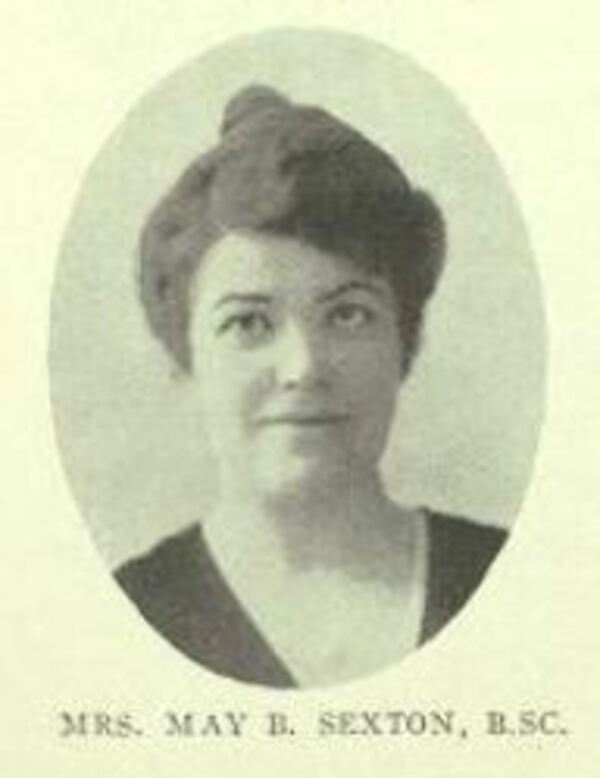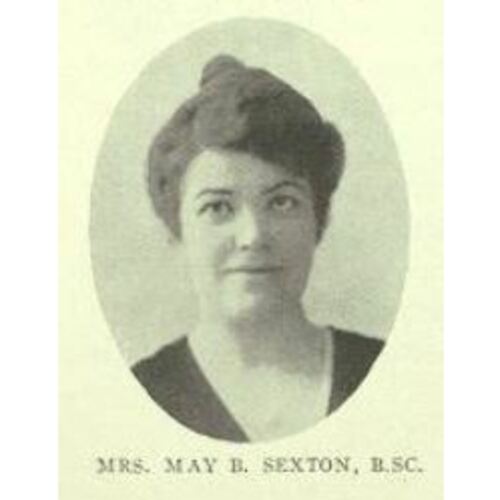
Source: Link
BEST, EDNA MAY WILLISTON (Sexton), feminist, social activist, and war worker; b. 25 June 1880 in Shediac, N.B., daughter of James Edward Best and Maria Porter; m. 25 June 1904 Frederic Henry Sexton, and they had a son and a daughter; d. 14 Dec. 1923 in Halifax.
May Best’s father, a merchant and native of Horton, N.S., fell on hard times after the death of his first wife in 1864. He moved to Shediac, where he remarried, taught school, and then took up farming. Both he and his second wife died prematurely; May was subsequently raised by family in Boston. Endowed with “striking intellectual ability,” she completed the Girls’ High School there, entered the Massachusetts Institute of Technology in 1898, and obtained a bachelor of science degree in 1902 with high honours in chemistry. After working briefly in the research laboratory of the General Electric Company at Schenectady, N.Y., she married colleague Frederic Sexton (MIT, sb 1901), who had just been appointed to Dalhousie University, Halifax.
Sexton embraced the life of faculty wife and young mother, but chafed at the limitations of a backwater community still resistant to the full participation of women in civic and intellectual life. Disinclined to pursue the traditional routes of church and charitable volunteerism, she sought other outlets for her restless energy. She became a board member in 1905 of the Ladies’ Musical Club of Halifax, founded that year by Kate Mackintosh and others, and used it as an entrée to the Local Council of Women. Within the LCW she established herself as an able committee person, podium speaker, and newspaper columnist, involved in almost every issue the council championed after 1906, including objectionable literature, public health, care of the feeble-minded, the prevention and treatment of tuberculosis, the playground movement [see Mabel Phoebe Peters*], and consumer advocacy. Some of these causes were also central to the Imperial Order Daughters of the Empire, in which Sexton was active after 1909, serving a term as first municipal regent.
Frederic Sexton’s appointment in 1907 as founding principal of the Nova Scotia Technical College positioned the young couple to become leaders in progressive education and social reform. During 1908–9, for example, May Sexton campaigned vigorously but unsuccessfully in favour of an industrial school for young women, arguing that such training would equip them to enter the workforce with a competitive advantage as skilled domestics, dressmakers, seamstresses, and milliners. As the issue of female enfranchisement resurfaced provincially during the pre-war years, both husband and wife publicly supported the appointment of women to school boards. This was viewed as a preliminary step in the campaign for voting rights and was a measure endorsed repeatedly by the LCW. In April 1913, as yet another enabling bill proceeded through the legislature, Sexton was one of a trio who represented the LCW before the Legislative Council, “making out their case with admirable clearness and reasonableness”; yet again, however, the initiative was lost.
With the declaration of war on 4 Aug. 1914, Halifax was changed overnight from a sleepy and complacent imperial outpost into a marshalling station for Canada’s overseas efforts; the need for timely and effective response from its citizens was unprecedented. From within a generally disorganized private sector, the LCW emerged as a leader in the civilian war effort. Meeting on 5 August, the council established a “Central Red Cross and Relief Committee for the Women of the Province,” endorsed by the military and charged with coordinating the entire provision of hospital supplies from Nova Scotia, for both overseas and home-defence needs. The vision of the committee as a province-wide agency had been Sexton’s idea.
Initially the production and packing of supplies was carried out at the LCW’s headquarters. From June 1915, however, Principal Sexton made the technical college available; his wife served as chair of the work committee. Bringing her “very strong executive ability” and “outstanding personality” into this charged atmosphere, Sexton organized parties of up to 100 women daily into assembly-line teams, complete with project supervision and product inspection. Each team produced a specific item on a weekly rota – hospital suits, bathrobes, shirts, pyjamas, socks, pneumonia jackets, surgical dressings and bandages, sheets, pillow cases, towels, operating gowns and masks – and, over the duration of the war, together they assembled some 10,635 Christmas stockings filled with treats. The Red Cross was especially proud of the egalitarian nature of these work parties, which crossed the colour line and included women of all ages from all social classes.
In order to attract the considerable sums needed to sustain these and other Red Cross initiatives, Sexton began fund-raising in 1915 through a series of patriotic lectures delivered around Nova Scotia. Audiences warmed to her “charming and clever manner” as she presented “Principal Sexton’s New War Slides,” accompanying them with a commentary which “brought the awfulness of war home to us,” the minutes of one organization recorded, “in a way that all detailed newspaper accounts never could.” On one occasion in Halifax, her presentation to the Rotary Club resulted in commitments from over 500 city businessmen, each undertaking to contribute $2.00 per month indefinitely for hospital supplies. On another occasion, she persuaded miners and steelworkers in New Glasgow, Trenton, and Westville to pledge payroll deductions totalling $5,000 monthly for general war work. Sexton was not the only Red Cross fund-raiser active in Nova Scotia, but her eloquence and determination were significant factors in the province’s phenomenal war record: an estimated $1 million was raised for the Canadian and British Red Cross societies alone over a four-year period.
From its establishment in 1914 the Nova Scotia branch of the Red Cross grew rapidly under the presidency of Agnes Dennis [Miller*], attracting the best of Halifax’s clubwomen. Its principal strength lay in a large but extremely efficient administrative structure; at its zenith, this consisted of five vice-presidents, Sexton included, with an executive committee of over thirty. Together, these women could respond almost immediately to any emergency. Entirely a woman-led organization, the Red Cross nevertheless worked effectively with various Halifax businessmen, chiefly because of the financial management or philanthropic assistance they could provide. Although there were other civilian organizations active provincially in the war effort, many of them women-based, none ever achieved the prominence or service record of the Red Cross.
As the war progressed, the Nova Scotia branch diversified into new activities focused on troop movements through Halifax. A subcommittee under Sexton provided volunteers to meet all incoming hospital vessels and assist in trans-shipment to outgoing hospital trains. In 1916, responding to the influx of invalided soldiers into the city’s overcrowded military facilities, the organization offered to set up and finance a 25-bed convalescent home. The immediate objective was to assist a group of frostbitten Jamaican soldiers left without care as a result of international bureaucratic wrangling. A committee co-chaired by Sexton and Joseph Linton Hetherington negotiated government approval, and then worked closely with the IODE and local benefactor William James Clayton to establish the home, which drew attention as the first wartime convalescent facility in Canada to provide vocational training.
In the aftermath of the Halifax explosion in 1917 Sexton’s formidable abilities were called upon yet again. On the day of the disaster the Canadian Red Cross set up a medical supply committee, co-chaired by Sexton and responsible for coordinating 44 volunteers in the purchase and delivery, twice daily, of all the supplies required by each of the 57 temporary hospitals and dressing stations scattered throughout Halifax and Dartmouth. For a time this initiative largely diverted the work of Sexton’s hospital supply teams and entirely drained their inventory. The committee, which worked 12- to 15-hour days initially, continued well into 1918.
With the end of the war imminent, the focus of attention shifted to returning soldiers; once more, Sexton was in demand. In 1918 she became replacement convenor of the Red Cross hospital committee. She immediately enlarged it and introduced the most recent British standards regarding convalescent care and volunteer services. Libraries and sun parlours were installed in Camp Hill Military Hospital and a large roster of weekly visitors was organized. Also during 1918 the military canteen in Halifax originally established by the American National Red Cross was briefly under Sexton’s “brilliant management”; in one month alone, 3,000 meals were served to transient soldiers.
Like many other Halifax women drawn into the war effort, Sexton participated fully in other community-based groups, chiefly the LCW, the IODE, the Halifax Playgrounds Commission, and, in 1917-18, the short-lived Nova Scotia Equal Franchise League, of which she was third vice-president and which saw the vote for women finally become a reality in Nova Scotia [see George Henry Murray]. Apart from public advocacy, Sexton excelled at coordination, bringing structure to various initiatives and liaising effectively with other women leaders such as Edith Jessie Archibald*, Charlotte McInnes, and Eliza Ritchie*. She was arguably Nova Scotia’s most visible war worker and, among her generation, the Nova Scotian woman most committed to broad social action and best equipped to articulate the necessary strategies.
All this did not come without cost. Late in 1918 Sexton’s health broke completely. She retired from public life and although she subsequently travelled extensively with her husband, she did not recover. Rarely seen in public, she was nevertheless consulted continuously by those who shared her deep commitments. Her death in 1923 from uraemic poisoning was sudden but not unexpected. Eulogized by the Halifax Herald as “a born leader, magnetic, full of enthusiasm in all good,” she was mourned throughout Nova Scotia.
NA, RG 31, C1, 1881, Shediac, N.B., div.3: 39 (mfm. At PANB). NSARM, MG 20, 160; 183, no.1; 204; 321; 535; 567, no.1 (mfm.); RG 32, M, Kings County, no.64/1852. St Andrew’s Anglican Church (Shediac), RBMB, 17[?] Nov. 1868, 29 Aug. 1880 (mfm. at PANB). Christian Messenger (Halifax), 28 Sept. 1864. Halifax Herald, 15 Dec. 1923. Morning Chronicle (Halifax), 15, 17 Dec. 1923. Presbyterian Witness (Halifax), 17 July 1852. Canadian Red Cross Soc., Nova Scotia Div., Annual report ([Halifax]), 1918–19; Nova Scotia Red Cross during the Great War, nineteen fourteen–eighteen (Halifax?, 1919?). C. L. Cleverdon, The woman suffrage movement in Canada, intro. Ramsay Cook (2nd ed., Toronto, 1974). Directory, Can., 1871. Massachusetts Institute of Technology, Class of 1901, Decennial record, 1901–1911 (Boston, [1911]); Class of 1902, First record book . . . (Brookline, Mass., 1904). N.S., House of Assembly, Journal and proc. (Halifax), 1913. Nova Scotia’s part in the Great War, comp. and ed. M. S. Hunt (Halifax, 1920).
Cite This Article
Lois K. Yorke, “BEST, EDNA MAY WILLISTON (Sexton),” in Dictionary of Canadian Biography, vol. 15, University of Toronto/Université Laval, 2003–, accessed December 26, 2025, https://www.biographi.ca/en/bio/best_edna_may_williston_15E.html.
The citation above shows the format for footnotes and endnotes according to the Chicago manual of style (16th edition). Information to be used in other citation formats:
| Permalink: | https://www.biographi.ca/en/bio/best_edna_may_williston_15E.html |
| Author of Article: | Lois K. Yorke |
| Title of Article: | BEST, EDNA MAY WILLISTON (Sexton) |
| Publication Name: | Dictionary of Canadian Biography, vol. 15 |
| Publisher: | University of Toronto/Université Laval |
| Year of publication: | 2005 |
| Year of revision: | 2005 |
| Access Date: | December 26, 2025 |



